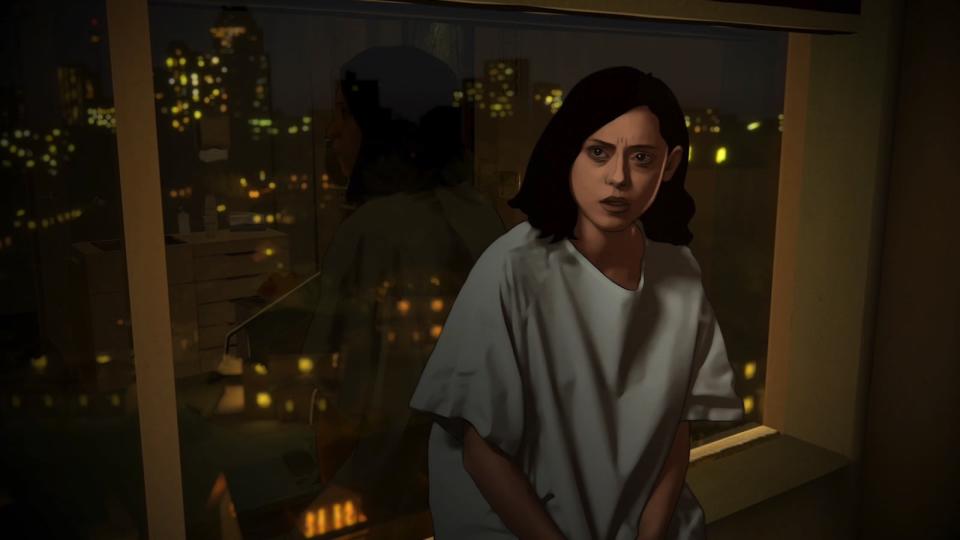Amazon's 'Undone' takes rotoscope animation to new heights
It's also one of the best sci-fi TV shows in years.
Undone, Amazon Prime Video's first animated series by Bojack Horseman writers Kate Purdy and Raphael Bob-Waksberg, is a staggering work of art. It starts out as a show about a wayward twenty-something woman bored with her lot in life, but it quickly turns into a psychedelic meditation on the nature of existence, time and the universe. After a serious car accident, Alma (Rosa Salazar, Alita) encounters the ghost of her dead father, who asks her to solve the mystery of his death. Oh, and to help her on her journey, she needs to learn how to manipulate the fabric of reality. No big deal.
Undone's rotoscoped animation style, which was produced by the studio Minnow Mountain and involves drawing over live-action footage, helps it stand out from everything else on TV today. Every second of the show makes it clear how far we've come from Richard Linklater's Waking Life and A Scanner Darkly, thanks to lush watercolor backgrounds and immersive three-dimensional environments. Undone is such a revelation I wouldn't be surprised if it leads to a revival of rotoscoping, a technique pioneered by the early 20th century animator Max Fleischer.
"We think that the show plays the tension of reality," Purdy said in an interview with Engadget. "The fact that it is both live action and animation simultaneously, allows you to come in and play with your imagination, but also to be stretched in terms of that kind of initial feeling of 'What is this? What is this that I'm seeing?'... The fact that it is moving between mediums or is existing simultaneously between these mediums is playing thematically with what the show is exploring."

After binging the entire series over the past week, it's hard to imagine Undone being presented any other way. Alma's journey gets trippy quickly — she might jump from floating in space to reliving a childhood memory of a family trip to Mexico. At one point, she runs down a seemingly infinite hallway as she encounters her past self. At times, Undone resembles the works of the anime director Satoshi Kon, who used the limitless potential of animation to craft scenes that would be incredibly expensive (and at times logistically impossible) in live action.
Surprisingly, Bob-Waksberg, who also created Bojack Horseman, says he and Purdy didn't write Undone with the intention of animating it. But upon reading the script for the first time, director Hisko Hulsing quickly realized that rotoscoped animation would be the ideal medium.

"He felt like they [the characters] were so emotional, it would be really hard to capture that emotion with traditional two-dimensional animated characters," Purdy said. "He recommended it [rotoscoped animation]... We already had concerns about capturing all that -- those micro-expressions and emotions -- and so it felt like the right choice. And then through the process of making this, I feel like Hisko made all of those advances and elevated the work. It's so lush and rich and also grounded at the same time."
Hulsing brought together rotoscoping with his own animation style. The result is a show that can hop between realistic scenes of family squabbles and otherworldly science fiction at the drop of a hat. And it often flips between those modes, like when Alma is struggling to hold onto reality while coming to grips with the secrets of the cosmos. (Or maybe it's all just a manifestation of her her own mental illness.)
Given just how few rotoscoped animation projects there are, Undone executive producer Tommy Pollota told Bob-Waksberg, every new entry inevitably begets new technologies and production processes. In this case, there was more computer imagery and 3D modeling involved, which helped to paint the reality an unreality of the world. But Bob-Waksberg also credits the rotoscoped artists at Minnow Mountain for their ability to capture actor's nuances.
"The rotoscope artist literally pick up everything and they choose what parts of your face they want to accentuate," he said. "You can actually be very subtle and I think these actors are incredible. Rosa we've said she has the face for rotoscoping because she's so expressive in the tiniest of ways and so subtle, but she can convey huge emotional shifts."

You might not recognize Salazar's face from Undone, but there's a good chance you've heard her voice. She also played the lead role in Alita: Battle Angel, which was motion captured using the same technology used in Avatar. Both techniques manage to capture a certain essence of Salazar's performance. But while I was wowed by the polished 3D animation in Alita, the hand drawn look of Undone does a better job of conveying her expressions and attitude.
In that respect, Undone represents everything I love about animation. It's a show that goes to some truly wild places. But what makes it work is its ability to convey humanity translated through human hands.
